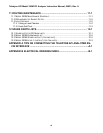Teledyne API Model 300M CO Analyzer Instruction Manual, 04033, Rev. A
1.3 Principle of Operation
The detection and measurement of Carbon Monoxide in the Model 300M is based on the
absorption of Infra Red (IR) radiation by CO molecules at wavelengths near 4.5 microns. As
illustrated in Figure 1-1, the Model 300M uses a high energy heated element to generate broad-
band IR light. This light is passed through a rotating Gas Filter Wheel causing the beam to
alternately pass through a gas cell filled with Nitrogen, (the Measure Cell) and a cell filled with
CO/Nitrogen Mixture (the Reference Cell). This alternation occurs at a rate of 30 cycles/second
and causes the beam to be modulated into Reference and Measure pulses. During a Reference
pulse, the CO in the gas filter wheel effectively strips the beam of all IR energy at wavelengths
where CO can absorb. This results in a beam which is unaffected by any CO in the Sample Cell.
During the Measure pulse, the Nitrogen in the filter wheel does not affect the beam which can
subsequently be absorbed by any CO in the sample cell. The Gas Filter wheel also incorporates
an optical chopping mask which superimposes a 180 Cycles/Second Light/Dark modulation on
the IR Beam. This high frequency modulation is used to maximize detector signal-to-noise
performance.
After the gas filter wheel, the IR beam enters the single pass sample cell. The beam then passes
through a band-pass interference filter to limit the light to the wavelengths of interest. Finally,
the beam strikes the detector which is a thermoelectrically cooled solid-state photo-conductor.
This detector, along with its pre-amplifier converts the light signal into a modulated voltage
signal.
The detector output is electronically demodulated to generate two DC voltages, CO MEAS and
CO REF. These voltages are proportional to the light intensity striking the detector during the
Measure pulse and Reference pulse, respectively.
1-3


















